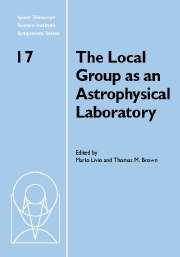 The Local Group as an Astrophysical Laboratory
The Local Group as an Astrophysical Laboratory Published online by Cambridge University Press: 12 May 2010
I review our understanding of the structure and kinematics of the Large Magellanic Cloud (LMC), with a particular focus on recent results. This is an important topic, given the status of the LMC as a benchmark for studies of microlensing, tidal interactions, stellar populations, and the extragalactic distance scale. I address the observed morphology and kinematics of the LMC; the angles under which we view the LMC disk; its in-plane and vertical structure; the LMC self-lensing contribution to the total microlensing optical depth; the LMC orbit around the Milky Way; and the origin and interpretation of the Magellanic Stream. Our understanding of these topics is evolving rapidly, in particular due to the many large photometric and kinematic datasets that have become available in the last few years. It has now been established that: the LMC is considerably elongated in its disk plane; the LMC disk is thicker than previously believed; the LMC disk may have warps and twists; the LMC may have a pressure-supported halo; the inner regions of the LMC show unexpected complexities in their vertical structure; and precession and nutation of the LMC disk plane contribute measurably to the observed line-of sight velocity field. However, many open questions remain and more work is needed before we can expect to converge on a fully coherent structural, dynamical and evolutionary picture that explains all observed features of the LMC.
To save this book to your Kindle, first ensure [email protected] is added to your Approved Personal Document E-mail List under your Personal Document Settings on the Manage Your Content and Devices page of your Amazon account. Then enter the ‘name’ part of your Kindle email address below. Find out more about saving to your Kindle.
Note you can select to save to either the @free.kindle.com or @kindle.com variations. ‘@free.kindle.com’ emails are free but can only be saved to your device when it is connected to wi-fi. ‘@kindle.com’ emails can be delivered even when you are not connected to wi-fi, but note that service fees apply.
Find out more about the Kindle Personal Document Service.
To save content items to your account, please confirm that you agree to abide by our usage policies. If this is the first time you use this feature, you will be asked to authorise Cambridge Core to connect with your account. Find out more about saving content to Dropbox.
To save content items to your account, please confirm that you agree to abide by our usage policies. If this is the first time you use this feature, you will be asked to authorise Cambridge Core to connect with your account. Find out more about saving content to Google Drive.